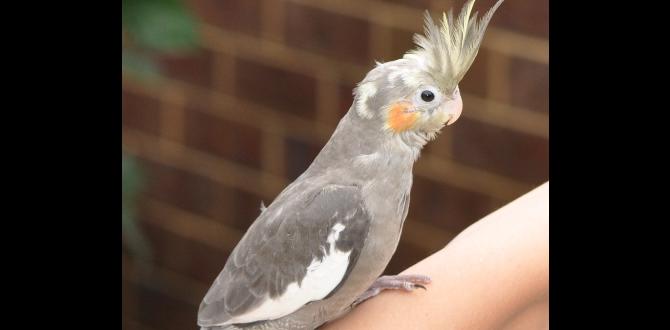Have you ever wondered if your cockatiel is a boy or a girl? It’s a question many bird lovers ask. These colorful birds can sing beautifully, but did you know their songs might tell their secrets? Boys often make more noise. Surprised? When looking at their plumage, boys and girls often differ subtly in colors. Boys tend to have bright cheek patches, like a sunset. If you’re thinking about getting one, or already have a feathery friend, knowing how to identify the gender of a cockatiel adds depth to your bond. Plus, it’s a fun discovery journey! Imagine having a treasure hunt right in your home. Ready to embark on this adventure? Let’s dive into the world of cockatiels and unravel these mysteries together.

How To Identify The Gender Of A Cockatiel: A Guide

How to Identify the Gender of a Cockatiel
Have you ever wondered if a friend’s cockatiel is a he or a she? Knowing a cockatiel’s gender helps with bonding and care. You can spot differences in their feather patterns. Male cockatiels have bright yellow faces and bold cheek patches, while females have duller colors. Listen to their songs, too. Males chirp tunes, while females stick to simple whistles. Use these clues, and become a cockatiel detective! Isn’t it fun to solve birdy mysteries?
Understanding Cockatiel Physical Differences
Differentiating male and female cockatiels by crest and face colors. Differences in body markings and patterns between genders.
Male and female cockatiels look different. You can often tell them apart by looking at their crest and face colors. Males usually have bright yellow faces. Females have duller faces and may have stripes on their tails. Here are some ways to tell them apart:
- Crest and Face Color: Male faces are bright yellow. Female faces are greyer.
- Body Markings: Female cockatiels often have stripes or spots under their tails.
How can I easily identify my pet’s gender?
Look at their face. Male cockatiels have brighter faces and crests. Female cockatiels have duller colors. Also, check for stripes under their tails.
Why is color important in cockatiels?
Color tells gender. Male and female cockatiels show different color patterns. This helps us tell them apart quickly.
Behavioral Traits Indicating Gender
Identifying gender through vocalizations and singing. Observing mating and nesting behaviors.
Male and female cockatiels can be told apart by their behaviors. Males often sing and whistle more. They might even talk! In contrast, females usually stay quieter. During mating time, you might see males performing courtship dances. They bend forward and tap their beaks. Females show interest by watching and softly chirping. When nesting, females build nests and stay inside more than males. Keep an eye out for these actions!
How can you tell if a cockatiel is male by its behavior?
A male cockatiel will sing and whistle often. He may perform dances to impress a female. These actions help identify him as male.
Do female cockatiels sing?
Female cockatiels are usually less vocal. They chirp softly but rarely sing or imitate sounds like males do.
What are nesting behaviors in cockatiels?
- Females prepare nests.
- They stay more in nests when laying eggs.
- Males may help but are less involved.
Age and Maturity Considerations
Changes in physical traits as cockatiels mature. Differences in gender identification at various life stages.
As cockatiels grow up, their physical features change like a superhero transforming! Young cockatiels look similar but become easier to tell who’s who as they mature. Male birds often develop brighter cheek patches and become more talkative, like a chatty uncle. Females, on the other hand, display more subtle colors and intricate patterns which are like their unique signature. Gender traits are influenced by the bird’s age. In juveniles, it’s like playing a guessing game, but adults reveal clues.
| Life Stage | Physical Trait | Gender Clue |
|---|---|---|
| Juvenile | Similar coloring | Hard to tell |
| Adult | Bright plumage (Males) | Noticeable differences |
Amid their chirps and beeps, remember, every bird is unique! Just like people! Look for these hints over time. But don’t rush. It’s like waiting for a magic reveal at a party—it’ll happen!
Genetic Testing for Definitive Results
Advantages of using DNA testing for gender identification. How and where to get DNA tests for cockatiels.
Ever wondered whether your chirpy cockatiel is a boy or a girl? Well, wonder no more! DNA testing is the superhero of bird gender identification. It’s super reliable and pretty much foolproof. You can get this test done by sending a cheek swab or a feather sample to special labs. These labs are basically cockatiel detectives. Websites like “Araceli Labs” or “Animal Genetics” are great places to start. You gather the sample, mail it, and voilà! You’re on your way to solving the mystery.
| Testing Option | Reliability | Where to Perform |
|---|---|---|
| Cheek Swab | High | Animal Genetics |
| Feather Sample | Very High | Araceli Labs |
Now you can confidently name your feathered friend, knowing you’ve got the inside scoop. Plus, you’ll have a nifty story to tell when people ask, “How did you find out?”
Common Myths and Misconceptions
Debunking myths about gender identification in cockatiels. Common mistakes owners make when identifying gender.
Many people get confused when identifying a cockatiel’s gender, believing wild tales. Guessing by tail feathers? That’s like guessing a dog’s breed by its bark! Female cockatiels aren’t the noisy neighbors; males are the ones singing loud tunes. Another myth is that only males have bright cheek patches, but both can flaunt their colors. Owners often assume a quiet bird is female, but even a shy male can fool you. Remember, the best gender reveal isn’t a party—it’s a DNA test!
Conclusion
To identify a cockatiel’s gender, look at its color, listen to its calls, and watch its behavior. Males often sing more and have brighter colors. Females may be quieter and have paler colors. Check with an expert if you’re unsure. Keep learning and caring for your cockatiel by reading more about their care and habits.
FAQs
What Are The Visual Differences Between Male And Female Cockatiels That Can Help In Identifying Their Gender?
Male and female cockatiels often look different. Males usually have bright yellow faces with orange cheek patches. Females often have duller or grey faces and less bright cheeks. You might also notice that males have clearer lines or spots under their wings. These differences help you tell if a cockatiel is a boy or a girl.
How Does The Behavior Of Cockatiels Vary Between Males And Females, And Can These Differences Be Used To Determine Their Gender?
Male and female cockatiels often behave differently. Boys usually sing more and can mimic sounds like words better. Girls are quieter and chirp less. You can use these differences to help guess if a cockatiel is a boy or girl, but it’s not always exact. Sometimes, other things, like colors, can help too.
At What Age Do Cockatiels Start To Show Signs Of Gender Differentiation?
Cockatiels start to show signs of being a boy or girl when they are about 6 to 9 months old. During this time, their feather colors can change. Boys often become brighter and may sing more. Girls usually have softer colors and chirp less. It can be fun to watch them grow and change!
Are There Any Specific Vocalizations Or Songs That Are Unique To Either Male Or Female Cockatiels?
Yes! Male cockatiels often sing more and have more varied tunes than females. They use songs to impress female cockatiels. Female cockatiels usually make simple sounds and chirps. Both can be playful and chatty, but males are known for their unique songs.
Can Genetic Testing Be Used To Determine The Gender Of A Cockatiel, And How Accurate Is This Method Compared To Visual Identification?
Yes, genetic testing can tell if a cockatiel is male or female. It is very accurate, almost 100%. This is better than just looking because visual clues can be tricky. So, genetic testing is a great way to be sure about a cockatiel’s gender.
